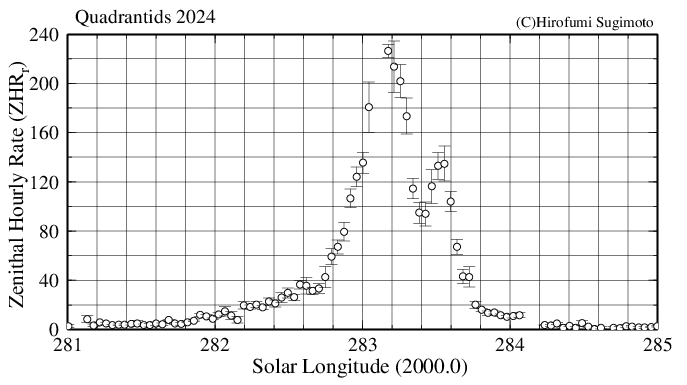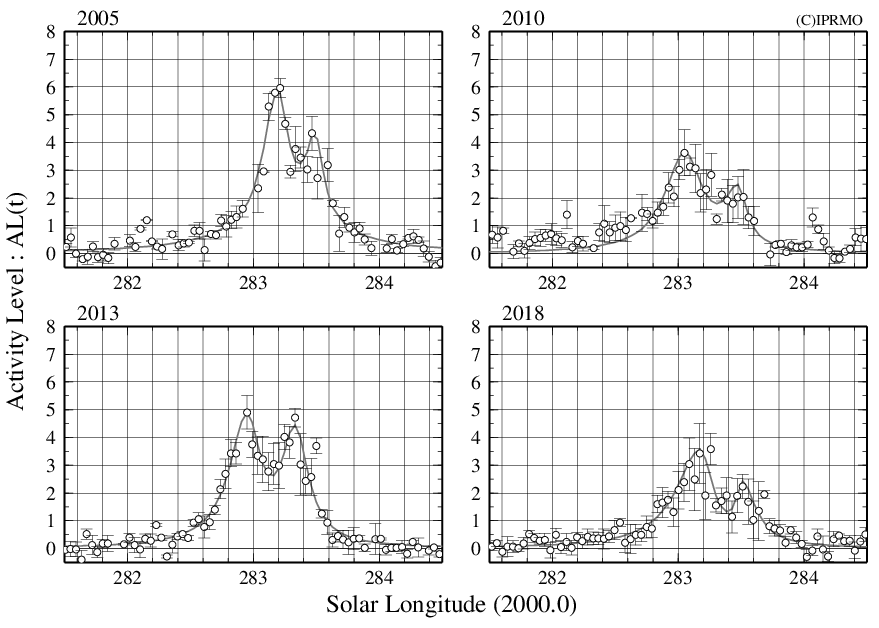Hiroshi Ogawa and Hirofumi Sugimoto
Abstract: The Quadrantids 2024 showed a much higher activity than on average during past years. The peak was recorded with AL = 8.3 ± 1.3 and a ZHRr = 226 ± 5 at λʘ = 283.04°– 283.17° (2024 January 4, 6h30m – 9h30m UT). Also, a sub-peak has been observed after the main peak which reached AL = 7.4 ± 1.1 and a ZHRr = 135 ± 14 at λʘ = 283.43°– 283.55° (2024 January 4, 15h30m – 18h30m UT). As a result, this activity has been observed separately as two components, one was the regular activity which had AL = 8.5 at λʘ = 283.13° and the other was a sub-peak with AL = 6.5 at λʘ = 283.47°. The enhanced regular activity such as in 2024 has been also observed in the past. On the other hand, however, a strong sub-peak after the main peak has never been observed in past.
1 Introduction
The Quadrantids are one of most famous annual meteor showers. The regular peak reaches Zenithal Hourly Rate (ZHR) = 80 at λʘ = 283.15° (Rendtel, 2023). For 2024, the regular peak was predicted at λʘ = 283.15° (January 4, 9h00m UT).
Radio meteor observing allows to obtain a complete activity profile even with bad weather and during daytime. Besides, the International Project for Radio Meteor Observations (IPRMO) has been organized to analyze the entire meteor shower activity without any radiant problems in 2001 (Ogawa et al., 2001). During past research, the activity profiles were derived from worldwide radio data from the Radio Meteor Observation Bulletin (RMOB).
The Quadrantid activity has also been analyzed by IPRMO. The average value for the period of the past 10 years has an Activity Level Index (AL) = 4.5 at λʘ = 283.15° (Ogawa, 2022). Besides, Ogawa and Steyaert (2017) described that the maximum was sometimes observed with a higher activity than during most annual returns.
This paper reports the result obtained for the Quadrantids 2024 using worldwide radio meteor observations.
2 Method
To analyze the worldwide radio meteor observation data, the meteor activity is calculated by the “Activity Level Index: AL(t)” (Ogawa et al., 2001) and the estimated Zenithal Hourly Rate: ZHRr(t) (Sugimoto, 2017). A lot of meteor showers have already been analyzed by this method.
3 Results
3.1 Activity Level Index
Figure 1 shows the result for the Activity Level Index. A gray line means an average for the period of past 10 years by IPRMO. A main peak was detected with AL = 8.3 ± 1.3 at λʘ = 283.04° (January 4, 6h30m). The maximum peak was one and a half times stronger in activity. Although the peak time was earlier than for the past average, it seems that this was caused by a few reports. A second peak was observed at λʘ = 283.43° (January 4, 15h30m). The AL reached 7.4 ± 1.1, the second peak was weaker than the main peak.

Figure 1 – The activity Level Index for the Quadrantids 2024 using 39 datasets from 10 countries (gray line: average for the period of the past 10 years).
Figure 2 shows an estimated activity profile using a Lorentz profile. A first peak had AL = 8.5 at λʘ = 283.13° (January 4, 8h30m) with FWHM = –0.25°/+0.15° and a second peak had AL = 6.5 at λʘ = 283.47° (January 4, 16h30m) with FHWM = –0.15°/+0.15°. The first peak was at the same time as the regular maximum (λʘ = 283.15°).

Figure 2 – The components of the Activity Level Index for the Quadrantids 2024 (squares: component of the first peak, triangles: second peak, solid line: first and second peak).
3.2 Estimated ZHRr
Since the Activity Level Index is difficult to compare to visual observations, an estimated ZHRr was calculated in Figure 3. The first peak reached ZHRr = 226 ± 5 at λʘ = 283.17° (January 4, 9h30m). Although this is later than in Figure 1, it is difficult to conclude when exactly a first peak occurred because there was not enough data available. A second peak has been recorded with ZHRr = 135 ± 14 at λʘ = 283.55° (January 4, 18h30m). This peak occurred later and weaker than in Figure 1, both figures have large error margins around the time of the second peak. Therefore, it is difficult to conclude when a second peak occurred.

Figure 3 – The ZHRr-distribution for the Quadrantids 2024 using 41 datasets.
4 Discussion
4.1 Influence of the zenithal effect
Section 3 described that the Quadrantids 2024 had two peaks. When a radiant of a meteor shower which has an average geocentric velocity is located near the zenith, the number of meteor echoes decrease temporary. This is called the “zenithal effect”. The radiant of the Quadrantids comes near the zenith for most observing stations in the Northern hemisphere. Therefore, it is necessary to consider which data to use.
This study has already taken into account this effect and data from locations with the radiant located near the zenith as well as with the radiant at too low elevation had been removed. Therefore, it can be concluded that the double peak was not caused by the zenithal effect.
4.2 Past records
The Quadrantids sometimes show a strong activity. A recent result with AL = 7.8 ± 1.1 has been recorded at λʘ = 283.11° in 2021. A value of AL = 7.5 had been estimated for the main component (Ogawa and Sugimoto 2021). Moreover, other surprisingly rich activities have been observed in 2021, 2019, 2016, 2014, 2004 and 2002 since this project started in 2001 (Table 1).
Table 1 – Strong main activity peaks recorded during past years (average for the period of 2002–2023).
| Year | λʘ (˚) | Activity Level (AL) |
| 2004 | 283.31˚ | 9.0 |
| 2014 | 283.11˚ | 8.0 |
| 2016 | 283.14˚ | 8.0 |
| 2019 | 283.17˚ | 8.5 |
| 2021 | 283.11˚ | 7.5 |
| 2024 | 283.13˚ | 8.5 |
| average | 283.15˚ | 4.5 |
A double peak has also been detected in the past. Figure 4 and Table 2 show a similar case in 2024. Although a sub peak after the main peak has been detected, it has never reached an activity as strong as in 2024. The activity level in 2024 was two or three times higher than in past years.
On the other hand, a sub-peak did not only occur after the main peak but also before the main peak such as in 2021 and in 2019.

Figure 4 – Similar results from past years comparable to the 2024 Quadrantids. (solid line: estimated activity profile (main + sub-peak component).
Table 2 – Sub-peaks that occurred after the main peak in past years.
| Year | λʘ (˚) | Activity Level (AL) | ZHRr |
| 2005 | 283.51˚ | 3.0 | 85 (λʘ =283.51˚) |
| 2010 | 283.48˚ | 2.0 | 45 (λʘ =283.52˚) |
| 2013 | 283.33˚ | 4.0 | 65 (λʘ =283.50˚) |
| 2018 | 283.51˚ | 2.0 | 45 (λʘ =283.56˚) |
| 2024 | 283.47˚ | 6.5 | 110 (λʘ =283.55˚) |
5 Conclusion
Radio meteor observations in the world detected a double peak in 2024. The main peak (at λʘ = 283.13°) produced higher activity than the long-term average. A high activity such as in 2024 has also been observed during several years in the past.
A sub-peak after the main peak has also been observed in the past. But the activity level in 2024 was much higher than during past Quadrantid displays.
Acknowledgment
The worldwide radio data were provided by the Radio Meteor Observation Bulletin (RMOB). We wish to thank Pierre Terrier for developing and hosting rmob.org.
References
Ogawa H., Toyomasu S., Ohnishi K., and Maegawa K. (2001). “The Global Monitor of Meteor Streams by Radio Meteor Observation all over the world”. In, Warmbein Barbara, editor, Proceeding of the Meteoroids 2001 Conference, 6-10 August 2001, Swedish Institute of Space Physics, Kiruna, Sweden. ESA Publications Division, European Space Agency, Noordwijk, The Netherlands, 189–191.
Ogawa H. and Steyaert C. (2017). “Major and daytime meteor showers using global radio meteor observations covering the period of 2001-2016”. WGN, Journal of the IMO, 45, 98–106.
Ogawa H. and Sugimoto H. (2021). “Quadrantids 2021 with Worldwide Radio Meteor Observations”. eMetN, 6, 271-273
Ogawa H. (2022). “Long-Term Studies of Major and Daytime Meteor Showers using Worldwide Radio Meteor Observations”. WGN, Journal of the IMO, 50, 148–157.
Rendtel J. (2023). “2024 Meteor Shower Calendar”. International Meteor Organization
Sugimoto H. (2017). “The new method of estimating ZHR using Radio Meteor Observations”. eMetN, 2,
109–110.

